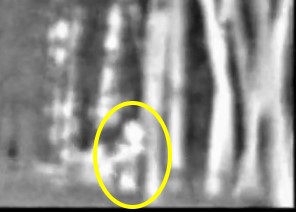
See Squeaky Highlights on YouTube
(click image above)
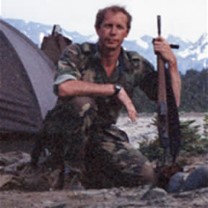
See Mike Greene's web site:
WWW.BUSHLOPER.NET
(click image above)
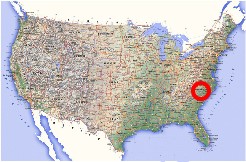
Film site in the Eastern U.S.
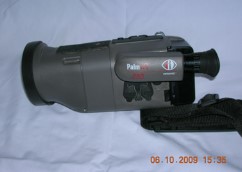
Thermal imaging device used
to obtain the footage.
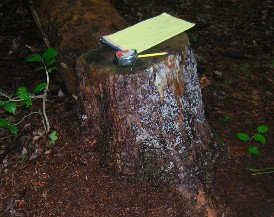
The stump "altar" on which the
curiosity items were set out.

The forest behind the stump altar.

Mike speaking at the Yakima
party for Bob Gimlin
|
To see the full "Squeaky" footage you'll have to download the whole thing. To download it you will need to pay $2.00 (as you would to download a movie on ITunes) to Mike Greene. It's worth it in this case, for reasons explained below.
We urge you to read everything below before you watch the footage, so you
understand the context and have greater appreciation for what you see.
"Thermal footage" is video footage shot with a thermal imaging
device. A thermal imaging device sees the
world in heat-vision like a snake, allowing the user to see in total darkness
without an illuminator.
Although thermal footage is much less clear than
footage obtained with a normal video camera, thermal cameras can do things that other devices cannot do. They are amazingly effective
at detecting warm-blooded animals in a forest at night. Nightvision devices
can also see in darkness, but cannot detect heat from animals.
The figure in this footage got the nickname "Squeaky" from some
of the items left for it at the tree stump "altar" of offerings, to
which the figure had been lured and habituated to over the course of two
(2) years.
Among the items intended to pique its curiosity were squeakable
bath toys, including a rubber ducky. Various toys were moved repeatedly
on the stump, and occassionally taken. Some were later found deep in the
woods. It was thought that whatever carried away the squeaky toys must
have noticed their squeakability at some point, and perhaps found them
curiously amusing -- hence the nickname "Squeaky".
There is a high degree of confidence among many members of the BFRO that
the Squeaky footage shows a real sasquatch. More than a handful
of BFRO members have reported direct observations of a sasquatch near
this spot, along with a long list of Class B incidents, over the past
three (3) years.
There is also high confidence in Mike Greene's credibility
as a bigfoot researcher, and confidence in his periodic trial-and-error
efforts at the site over the years. His patient approach was the most
logical, feasible strategy for getting a sasquatch on camera at that site. His success on this particular occasion demonstrated a new technique for obtaining footage -- the unattended camp.
The Squeaky footage, standing alone, is not persuasive to the average
person, nor will it be conclusive to any scientist. Consequently we faced
some familiar issues when deciding how to handle this footage: Do we show
poor quality footage to the public, which we feel, due to the circumstances,
is credible? What if it is such poor quality footage that the relevant
figure is barely visible, or the figure is so fuzy that it reveals no
immediate distinction from a bulky human silhouette? If not persuasive
on its own, does it have any value for the public?
In this case the answer is "yes" because of the amount of behavior
seen. If the footage authentic, as many of us believe, then these
behaviors are quite relevant to anyone else who will attempt similiar
camera-oriented habituations in other regions.
Mike Greene had been pursuing footage of a sasquatch as a hobby, off-and-on
for over 20 years. He has a Master’s degree in Behavioral Psychology, is
a court-qualified Questioned Documents Examiner ( forgery expert). For
two decades he was Chief of Welfare and Food Stamp Fraud Investigations
for New Jersey. Mike joined the BFRO in 2005 and attended 16 BFRO expeditions
in different parts of the US and Canada, incuding the yearly expeditions
in North Carolina, for which he was eventually asked to serve as the official
organizer.
On numerous occassions, at a particular location in North Carolina, various
expedition participants described seeing an inquisitive sasquatch circle
their camp just beyond the illumination of their campfire. Many of those
sightings happened within 200 feet of the spot where the Squeaky footage
was obtained. Various attempts were made to photograph this sasquatch using
trail cameras, with no success. The trail cameras were, out of necessity,
strapped to the sides of nearby tree trunks. They were conspicuous from
a distance. The stump altar would be raided when there were no trail cameras
on the nearby trees, but was not raided when trail cameras were present.
Not every trail cam approach was tested there (such as camouflaging the
cameras on the ground) before Greene switched to thermal equipment from
a greater distance. He switched to this different strategy after his first minor success there: His own observation
of a sasquatch there in 2007, while using a thermal viewer (Ratheon PalmIR
250).
Mike’s 2007 observation was not recorded. Why? The thermal is a separate device
from the recorder.
The recorder was turned off to save its limited memory (256mb SD card),
a mistake Mike vows never to repeat. The sasquatch left the scene in the time
it took Mike to fumble in the dark to power up the
recorder and put it in Record mode. Other people were present on that occasion.
All of them, including Mike, were sitting at the same picnic table talking
among each other, recreating the many prior scenarios when the sasquatch
was said to have circled and watched people there from the safety of the
surrounding woods.
Rather than bemoaning his first thermal sighting as a missed opportunity,
Mike treated it as an important confirmation for himself. Others in the
BFRO who greatly respect Mike's reliability for interpreting observations
in the field, especially observations using night-enabled optics, cited
Greene's thermal sighting in support of certain issues which we had previously
argued about among ourselves:
1) First Issue: Could thermal scopes see and distinguish sasquatches from
background foliage just as well as they could see and distinguish other
large animals in the woods, such as deer and bear? Prior to Mike's thermal
observation (which occurred prior to Don Young's thermal clip) several people
had claimed to observe sasquatches briefly using these same thermal viewers
(L-3 Comm. X200p and Ratheon PalmIR 250). Others had described approaches
in the dark (approaches involving clear distinguishers such as large branch
snapping, rock-throwing, etc.), but could not see the animals with the thermal
scopes (at least not where they expected to see them). This led some to
suspect sasquatches might not be very noticeable with thermal viewers, perhaps
because their bodies were so well insulated from the cold, and conservative
with their caloric energy, that they would not be dramatically warmer than
background trees, etc.
Mike's Squeaky footage demonstrated how a sasquatch can remain invisible while stalking
humans in a forest at night. Sasquatches will crawl on the ground among
the low brush and fallen logs, if necessary, to stay out of view. They are
large animals which can make themselves very small this way. Getting
down very low when approaching and fleeing allows them to quickly "disappear"
...
2) Second Issue: Could an adult sasquatch be "trained" to return
to a particular spot to take items left out for it. Many felt that adult
sasquatches were too cautious to do this, especially if it was obvious to
them that the human campers were aware of them. The sasquatches would get
indications of the human campers' awareness of them because of the mimicking
sounds the humans would make while in the area. The BFRO members would immitate
the common sounds of sasquatches in very conspicuous ways whenever they
visited the area.
Mike returned to the area repeatedly and eventually obtained a few minutes
of interesting footage showing the figure furtively approaching the altar.
The big difference on this occasion was that Mike left the campsite instead
of going to bed in his tent. He was in the process of setting up the thermal recorder
to shoot from the inside of his Toyota Highlander, out the back hatch when
he heard movement in the woods down behind the stump. On an impulse he put
the thermal on a small tripod, covered it with a scrap of camo cloth, and
drove off. He stayed away for over 2 hours.
Even when Mike was gone from the camp (there was no other campers
in the area either), the figure waited for 30 minutes before approaching, with
extreme caution.
Elsewhere in North America there is a small collection of more
compelling footage (some shot in daylight) where more than one sasquatch
can be seen in much greater detail. Some BFRO members helped obtain some
of those clips but the collection is currently in private hands and has
not been released. The owner of that collection (Adrian Erickson in Canada)
has been steadily (but slowly) preparing a full-length documentary film,
to present the collection in its proper context ... and also to recoup the
large investment he made to obtain most of the footage, while simultaneously
funding some formal research at the site. Erickson's approach is very thorough
and cautious, but his approach necessarily delayed the timely release of
his impressive collection.
In the case of Squeaky, Mike Greene wanted to release the footage sooner,
without waiting to obtain several more clips from the location, perhaps
delaying the release of "Squeaky #1" for a few years.
Mike's full length raw footage is roughly 3 and half minutes
long. It is not free to download. Per Mike's decision as the sole owner of the footage, and the sole owner of the
equipment used to obtain it (i.e. the footage was not obtained with loaned
BFRO equipment), the whole 3.5 minutes of unedited footage
can be downloaded as a single video file for $2.
The BFRO's position is that group members
can release their credible material in whatever way they choose, as long
as the description or promotion is not misleading or deceptive in any way.
The footage is available on Mike’s web site (Bushloper.net)
On his web site there are also photos, videos and other
info from the 20 years of his bigfoot-oriented explorations, from Bella
Coola, BC to the Everglades of Florida with the BFRO. It is an excellent
source of information for those interested in various types of night-optics
used by researchers.
This is very important footage because it was gotten with the new technique that others should try:
Get up and drive away from the camp at the first indication of a stalking sasquatch. Leave the camp unattended for at least one hour with the camera rolling, and aimed at the food pile near a treeline, near some big trees.
There is great potential in this method for daylight footage, and it has not been tried anywhere else. It should be tried a lot more, in a lot more places. It may be the easiest and most practical way to obtain clear, close-range footage in daylight, and it can be done easily with a newer hard-drive camcorder and an extended battery. Sony makes several High-Def hard-drive camcorders nowadys that can accommodate extended batteries that will give you 10 hours of continuous recording.
Tape camera or disc camcorders are not ideal for this because they don't record long enough before the media needs to be swapped.
The camcorder must be hidden among other camping gear so it is not conspicuously aiming at the food. This is where most people will fail, because they will underestimate the intelligence of these animals.
No one can remain hidden near the camp either. Squatches seem to know that trick and won't come near if they think someone is left behind to possibly ambush them. That is why Squeaky was so very cautious approaching the stump. It didn't know if someone was still in the tent.
For that reason it will be best to have no tent at all, rather just tarps, airmats, and sleeping bags, like a backpacker.
If you have a vehicle nearby, leave the camp and drive far enough away so your engine cannot be heard by anything up on elevation acting as a whistling sentry.
Mike Greene made sure no one could steal the expensive thermal camera by parking on the only road into the camp, but some distance away. For that reason, a camp at the end of a small spur off a desolate forest road, would be ideal for car campers, if good equipment were to be left there for several hours
If your camp is somewhere where no one can possibly spot it from a driveable road, then just stay far away for an hour or two. Let the camera do the work.
Don't be obvious about the camera when you return to the camp. Assume you are being watched and don't approach the food pile til morning.
That's the "Greene Method." Give it a try and make him proud. |




























